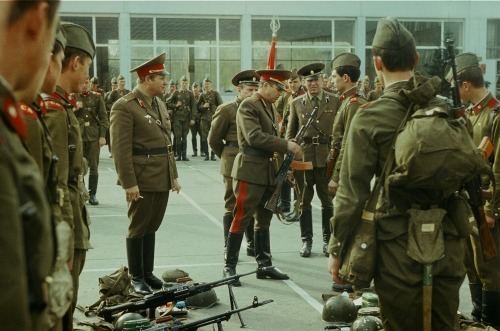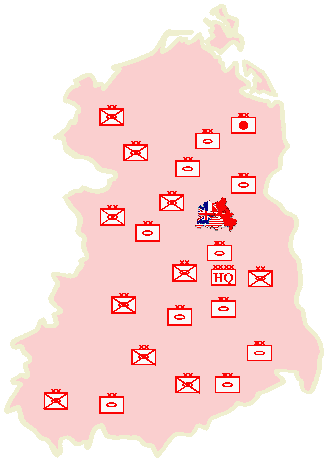Founded 16 March 1954 | ||
 | ||
T 80 mbt soviet army east germany
The Group of Soviet Forces in Germany (1954–88) (Russian: Группа советских войск в Германии, ГСВГ), also known as the Group of Soviet Occupation Forces in Germany (1945–54) and the Western Group of Forces (1988–94) were the troops of the Soviet Army in East Germany. The Group of Soviet Occupation Forces in Germany was formed after the end of the Second World War from units of the 1st and 2nd Belorussian Fronts. The group helped suppress the Uprising of 1953 in East Germany. After the end of occupation functions in 1954 the group was renamed the Group of Soviet Forces in Germany. The group represented Soviet interests in East Germany during the Cold War. After changes in Soviet foreign policy during the late 1980s, the group shifted to a more defensive role and in 1988 became the Western Group of Forces. Russian forces remained in Eastern Germany after the dissolution of the Soviet Union and the reunification of Germany until 1994.
Contents
- T 80 mbt soviet army east germany
- Garnision dessau soviet army gssd lost places germany 242 2015
- Structure and equipment in 1991
- Commanders in Chief of the GSFG
- References

Garnision dessau soviet army gssd lost places germany 242 2015
The Group of Soviet Occupation Forces, Germany was formed after the end of the Second World War from formations of the 1st and 2nd Belorussian Fronts, commanded by Georgy Zhukov. On its creation on 9 June 1945 it included:

An order of 29 May 1945 had ordered the disestablishment of the 47th, 77th, 80th, 89th, 25th, 61st, 91st, 16th, 38th, 62nd, 70th, 121st, and 114th Rifle Corps, and of the 71st, 136th, 162nd, 76th, 82nd, 212th, 356th, 234th, 23rd, 397th, 311th, 415th, 328, 274, 370, 41st, 134th, 312th, 4th, 117th, 247th, 89th, 95th, 64th, 323rd, 362, 222, 49th, 339, 383rd, 191st, 380th, 42nd, 139th, 238th, 385th, 200th, 330th, 199th, 1st, 369th, 165th, 169th, 158th, and 346th Rifle Divisions. The 89th Rifle Division was not disbanded and instead transferred to the Caucasus.
In January 1946, the 2nd Shock Army left the Soviet Zone. A month later, the 47th Army was disbanded, with its units withdrawn to the Soviet Union. In October the 5th Shock Army was disbanded. In 1947 the 3rd and 4th Guards Mechanized Divisions (Mobilization), former mechanized armies, arrived in the group from the Central Group of Forces. In 1954 the 3rd Shock Army became the 3rd "Red Banner" Combined Arms Army (Russian: 3-я краснознаменная общевойсковая армия). The 3rd Guards Mechanized Army became the 18th Guards Army on 29 April 1957. On the same day, the 4th Guards Mechanized Army became the 20th Guards Army.
After the abolition of the occupation functions in 1954, the Group of Soviet Occupation Forces in Germany became known as the Group of Soviet Forces in Germany (GSVG) on 24 March. The legal basis for the GSVG's stay in East Germany was the Treaty on Relations between the USSR and the GDR of 1955.
Withdrawals from East Germany in 1956 and 1957/58 comprised more than 70,000 Soviet army personnel, including 18th Army Staff.
The GSFG had the task to ensure for the adherence to the regulations of the Potsdam Agreement. Furthermore, they represented the political and military interests of the Soviet Union. In 1957 an agreement between the governments of the Soviet Union and the GDR laid out the arrangements over the temporary stay of Soviet armed forces on the territory of the GDR, the numerical strength of the Soviet troops, and their assigned posts and exercise areas. It was specified that the Soviet armed forces were not to interfere into the internal affairs of the GDR, as they had done during the Uprising of 1953 in East Germany.
Following a resolution of the government of the USSR in 1979/80 20,000 army personnel, 1,000 tanks and much equipment were withdrawn from the territory of the GDR, among them the 6th Guards Tank Division, HQ Wittenberg.
In the course of Perestroika the GSFG was realigned as a more defensive force regarding strength, structure and equipment. This entailed a clear reduction of the tank forces in 1989. The GSFG was renamed the Western Group of Forces on 1 June 1989. The withdrawal of the GSFG was one of the largest peacetime troop transfers in military history. Despite the difficulties, which resulted from the dissolution of the Soviet Union in the same period, the departure was carried out according to plan and punctually until August 1994. Between the years of 1992 and 1993, the Western Group of Forces in Germany (along with the Northern Group of Forces), halted military exercises.
The return of the troops and material took place particularly by the sea route by means of the ports in Rostock and the island of Rügen, as well as via Poland. The Russian Ground Forces left Germany on 25 June 1994 with a military parade of the 6th Guards Motor Rifle Brigade in Berlin. The parting ceremony in Wünsdorf on 11 June 1994 and in the Treptow Park in Berlin on 31 August 1994 marked the end of the Russian military presence on German soil.
In addition to German territories, the Group of Soviet Forces in Germany operational territory also included the region of town of Szczecin, part of the territories transferred from Germany to Poland following the end of the Second World War. The rest of Poland fell under the Northern Group of Forces, while the southern regions (Austria, Czechoslovakia) were under the Central Group of Forces.
Generals directing the withdrawals from Germany diverted arms, equipment, and foreign monies intended to build housing in Russia for the withdrawn troops. Several years later, the last GSFG commander, General Matvei Burlakov, and the Defence Minister, Pavel Grachev, had their involvement exposed. They were also accused of ordering the murder of reporter Dmitry Kholodov, who had been investigating the scandals.
Structure and equipment in 1991
The Soviet troops occupied 777 barracks at 276 locations on the territory of the German Democratic Republic. This also included 47 airfields and 116 exercise areas. At the beginning of 1991 there were still about 338,000 soldiers in 24 divisions, distributed among five land armies and an air army in what was by then the Western Group of Forces. In addition, there were about 208,000 relatives of officers as well as civil employees, among them about 90,000 children. Most locations were in the area of today's Brandenburg.
In 1991 there were approximately 4,200 tanks, 8,200 armored vehicles, 3,600 artillery pieces, 106,000 other motor vehicles, 690 aircraft, 680 helicopters, and 180 rocket systems.
At the end of the 1980s, the primary Soviet formations included:
Other Group-level formations included:
Commanders-in-Chief of the GSFG
The first three Commanders-in-Chief were also Chiefs of the Soviet Military Administration in Germany.
Members of the WGF military soviet in June 1993:
